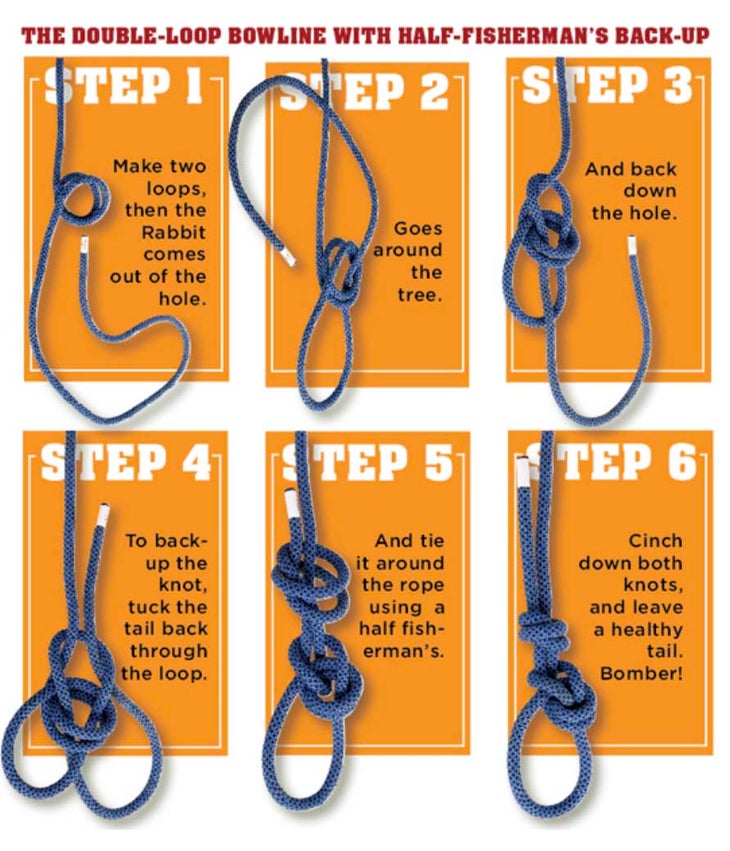Heading out the door? Read this article on the new Outside+ app available now on iOS devices for members! Download the app.
The poor double bowline has gotten a bad rap for coming untied when it was never properly tied in the first place. But for decades, pioneers such as Royal Robbins, Tom Frost, and Warren Harding safely used the double bowline as their climbing knot of choice. In the knot’s defense, the double-loop bowline—the only knot that is truly easy to untie after a fall—has worked flawlessly millions of times for climbers and sailors worldwide. Yet, if the knot causes accidents, it’s worth a closer look.
But before we do that, regardless of which knot you used to tie in, just a quick PSA that no knot is truly safe unless you double check it—and ideally have your partner check it, too.
Double bowline knot strength
According to Mountaineering: The Freedom of the Hills, a bowline will reduce a rope’s strength by 25 to 30 percent, compared to 20 to 25 percent for the retraced figure eight knot. Considering that the typical tensile strength of a lead rope is upwards of 5,000 foot-pounds, either knot—even after it has weakened the rope—is plenty strong.

Ease of tying a double bowline
The double-loop bowline and the retraced figure 8 (aka “trace 8”) are complicated knots that require practice. As Clifford Ashley noted in his 620-page The Ashley Book of Knots, “A knot is never ‘nearly right,’ it is either exactly right, or hopelessly wrong … ” Since tying both knots requires an equal skill level, a better measuring stick is to consider how the knots fare when you tie them the wrong way.
Watch pro climber Genevive Walker demonstrate how to tie in using a double bowline knot with a back-up
Typically, people screw up the bowline because they tuck the end of the rope down through the loops to begin, instead of out through the loops (step 1 in the image above). Make this mistake, and the bowline looks obviously wrong and tends to fall apart in your hands—but not always. In every documented case of double bowline failure, the knot either wasn’t tied properly, wasn’t cinched tight, and/or wasn’t backed up.
Typically, people screw up the bowline because they tuck the end of the rope down through the loops to begin, instead of out through the loops.
As for the trace-8, the common way to incorrectly tie it is when the climber doesn’t completely rethread the 8, stopping the knot short of actually being tied. Then, the trace-8 looks almost right and holds itself together, giving the illusion that it’s been properly tied. In some cases, a partly tied trace-8 has even held weight, and the unsuspecting climber didn’t know they’d blown it until they were back on the ground untying.
The takeaway: If you are going to tie a knot wrong, the trace-8 is the better one to botch.
Read our Complete Guide to Essential Climbing Knots
Testing and backing up your double bowline
Assuming you’ve mastered the double bowline, you can test its security by jiggling it. This simulates the action of a rope as it’s repeatedly pulled taut, then slacked off.
Do this test and you’ll find that the trace-8 is the least likely of the knots to untie itself.
In this sense, the trace-8 is safer, but only because you are not using a back-up knot—a dangerous but common practice, especially among high-end climbers. Finish either knot with a back-up and they are equally reliable.
Numerous back-up options exist, such as the popular overhand and half-hitch. But the half-fisherman’s back-up knot (aka grapevine) is superior. Although the half-fisherman’s eats up some rope and is bulky, it is unlikely to work loose, making the double-loop bowline and trace-8 blast-proof. And in the event that you do incorrectly tie your main knot, the half-fisherman’s can even hold weight by itself.
In the end, both tie-in knots have merit. If you are going to tie in sloppily and not use a back-up, the trace-8 is king. It’s the least likely of the knots to come untied, especially with a stiff rope. But the double-loop bowline remains a safe and valuable knot so long as you tie in carefully, tighten it, and use a back-up.
Knot tying checklist
Whether you’re trying a double bowline or something else, prevent accidents by using this checklist every time you tie in.
- Always check your knots.
- Visually inspect your partner’s knot before every pitch. If he or she leaves the ground before you can check, stop the show and ask, “How’s your knot?” Ask that they check it and show you.
- If someone asks you a question or tries to hand you something when you are tying your knot, finish before answering or taking the item. Do nothing else until the knot is complete. Likewise, hold off on conversation if your friend is tying his/her knot.
- Remember, a knot’s not finished until you tighten it. A stiff new rope is more likely to loosen. Reef on it. Weight it.
- Tie a back-up stopper knot above your knot. (And this is not one of the tenets to prevent the problem, but always carry a quickdraw. You could be glad.)